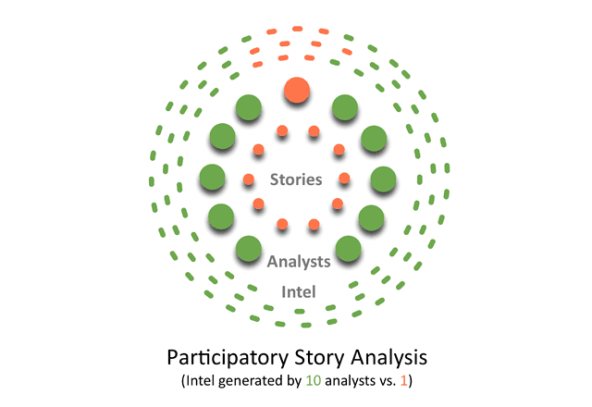The challenge of scaling up plagues thousands of thriving social enterprises that are keen to grow, yet lack business intelligence and models to advance their labors of love. Money Coaches Canada and the Women’s Financial Learning Centre, are good examples. Founded by the same expert team, the two enterprises offer independent, fee-only financial literacy services to educate and empower women. Both can demonstrate terrific impact but struggle to engage a mainstream audience.
To begin to address this challenge, I’m helping them conduct a relatively simple narrative analysis of their clients’ success stories as a way to generate intel that will inform their scaling strategies. The two companies have a combined roster of more than 2,500 alumni, all who have unique stories that contain specific details about how—exactly—they gained control of their finances. By collecting and analyzing a statistical sample of these stories, we’ll be able to find out what worked to help them make change and why. How did they identify barriers to managing finances? Set goals? Engage allies? Name fears? Change patterns? And after completing an initial story analysis, we’ll synthesize the aggregated story data to identify common trends and patterns. The research findings that emerge will inform the development of a systemic model of change that will guide scaling and impact strategy for both organizations.
I’ve used this technique dozens of times, across sectors and cultures. To me, it is the sweet spot of story strategy—an easy and powerful way to generate rich intel that offers greater potential for advancing social innovation than any other storytelling technique. No matter what topic I explore, the analysis never fails to yield valuable knowledge, expertise, and hindsight that incite innovation and inspire change. The best part is that the process is agile, affordable, and accessible. Unfortunately, many organizations today appear to have cast aside such participatory, qualitative research methods in their quest for the almighty big data.
In my two previous posts, I suggested that stories are simply descriptions of problems, quests, and solutions—neat packages that we store in our personal memory or story banks. Within each “quest” is information or data about how the story problem was resolved—wisdom, expertise, and ideas that we process subconsciously through narrative intelligence.
Are you enjoying this article? Read more like this, plus SSIR's full archive of content, when you subscribe.
At an organizational or community level, we can access these data in several ways. Traditional academic inquiry methods tend to focus on classic interview approaches—one interviewer with one or more subjects. However, I’ve had tremendous success with participatory, collective approaches and prefer them for several reasons.
Assuming that we have all narrative intelligence, then we’re also all experts (to some degree) at analyzing stories. If your research approach uses only one person—one researcher—to analyze a collection of stories about a specific topic, then you will yield only one interpretation of those stories’ meaning; one person is analyzing the story data through her single, personal lens of experience—her own unique lifetime story bank.
Now imagine methodically sharing, collecting, and analyzing stories about a specific topic in a group. Even if only 10 people shared one story each about a topic, you’d have 10 people analyzing 10 stories. Each person in the group would have a different analytical lens, depending on his own personal experience. As the graphic below shows, you’d have the potential for a tenfold increase in the generation of intel, insight, and inspiration from the analysis, and this would grow as you diversified the members of the group—and expanded the scale. I’ve used this method with 100 people in the room at a large institution; within an hour, we generated enough intel to drive a significant portion of their next strategic plan.

This kind of participatory research approach delivers rich insight. It also creates significant social value. No one person has the solution to a complex, wicked problem; this process enables systemic change by mobilizing expertise across communities of interest. It also empowers stakeholders by explicitly placing value on their expertise and experience. Finally, listening to and analyzing stories builds individual critical thinking expertise—an essential skill in advancing capacity for resilience and innovation.
What can you learn through this kind of research?
The human-centered intel that comes from story analyses complements quantitative data and big data in several ways. An important trait of story is that it makes the abstract concrete, revealing details about behavior and values. It typically does this by describing the activities of the main characters, as opposed to their thoughts. This can be beneficial to researchers, since what people actually do is often quite different from what they say. Study participants tend to tell researchers what they think researchers want to hear, which can make it tough to glean accurate data. Also, we sometimes underrate the value of human experience as a source of wisdom. By shifting our strategic focus to include insight and intel that is rooted in lived experience not just management theory, we can increase our confidence in the viability of our future plans and decrease risk.
Over the past 30 years, I’ve used story-based research for a variety of projects, including program evaluations, stakeholder research, ethnography, and envisioning. But the biggest opportunity I see today arises from the growth of contemporary social media technologies. Hundreds, if not thousands, of organizations currently have websites and tools that collect stakeholder stories online. Each of these story collections represents a wealth of data about specific topics that is just waiting for analysis and application. Organizations must not overlook this potential goldmine, and let their stories languish, untapped, in database oblivion.
Support SSIR’s coverage of cross-sector solutions to global challenges.
Help us further the reach of innovative ideas. Donate today.
Read more stories by Denise Withers.

